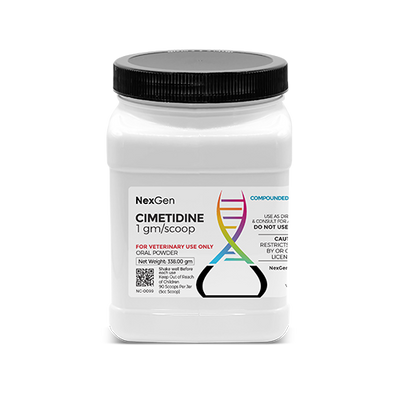
Omeprazole 1 gm/scoop + Cimetidine 500 mg/scoop, Oral Powder, 60 Scoops (9cc Scoop)
Login for pricing
- Brand
- Mixlab
- SKU:
- NC-0277
- Product Type:
- Powder
- Size:
- 32oz
- Administration:
- Oral
- Scoops Per Container:
- 60
- Scoop Size:
- 9cc
Gastric ulcers are sores that form in the lining of the stomach. They are common in horses, with a prevalence estimated between 50% and 90%. They can affect any horse at any age, but occur most frequently in horses that perform athletic activities such as racing, endurance, and showing.1 The reason for this is that exercise increases gastric acid production and decreases blood flow to the GI tract.
The stomach of the horse is relatively smaller in comparison to other species of comparable size. Additionally, a horse’s stomach has two sections: an upper non-glandular region where food enters the stomach, and a lower glandular region where hydrochloric acid (HCl) is produced.2 While the lower region is constantly exposed to gastric acids, it has better protection from these acids; thus, lesions are most commonly found in the upper region. Due to its stomach size, a horse cannot handle large amounts of food. When horses are fed two times per day (common during boarding situations), the stomach is subjected to a prolonged period without food to neutralize the acid. In addition, high-grain diets produce volatile fatty acids that can also contribute to the development of ulcers.1
In addition, when horses exercise, the acidic fluid in the stomach splashes and exposes the upper, more vulnerable portion of the stomach to an acidic pH. This syndrome (also called Equine Gastric Ulcer Syndrome or EGUS) results in ulceration and bleeding in some instances. Lastly, chronic administration of some nonsteroidal anti-inflammatory drugs (NSAIDs) can decrease the production of the protective mucus layer of the stomach, making it more susceptible to ulcers.1
Clinical Signs of Gastric Ulcers in the Horse
Most horses suffering from gastric ulcers do not exhibit overt clinical signs; often, these horses appear completely healthy. Some of the more subtle signs of EGUS can include:
-
Poor appetite
-
Weight loss
-
Dullness
-
Changes in mood and/or behavior
-
Decreased performance
-
Reluctance to train
-
Poor body condition
-
Dull coat
-
Colic
While spontaneous remissions of these lesions have been described in the literature, horses that remain in situations with the aforementioned risk factors are likely to remain ill without medical intervention.2 Foals are known to be at high risk for development of perforating peptic ulcers until they are several weeks old due to the undeveloped state of their gastric mucosa. In some instances, horses are found on their backs (this is especially common with foals), since this position seems to provide some relief from severe gastric ulceration. Some horses will walk away from food if they experience discomfort when the food first reaches the stomach.1 In foals, the clinical signs of ulcerative disease can also include intermittent colic, frequent recumbency, reduced nursing, diarrhea, poor appetite, a pot-bellied appearance, grinding of teeth, and excess salivation.4 If a foal exhibits clinical signs, the ulcers are likely to be severe and should be diagnosed and treated immediately.
Gastric ulcers can only be definitively diagnosed through endoscopy. This involves inserting the endoscope into the stomach and performing a visual examination of the stomach mucosa. This procedure is minimally invasive and allows for a thorough examination of the esophagus, stomach, and small intestine.3
Treatment of Gastric Ulcers in Horses
Cimetidine competitively inhibits histamine at the H2 receptors of the parietal cells, thereby reducing gastric acid output both during basal conditions and when stimulated by food, pentagastrin, histamine, or insulin.4
Cimetidine is a CLASS 5 DRUG under the Association of Racing Commissioners International (ARCI) Uniform Classification Guidelines for Foreign Substances (UCGFS).
Where to buy Omeprazole + Cimetidine
Omeprazole + Cimetidine is available in the U.S. through several pharmaceutical manufacturers and through veterinary custom compounding companies.
This product carries numerous potential drug interactions. Please consult your veterinarian prior to beginning any treatment regimen.
FOR RX ONLY: A valid prescription from a licensed veterinarian is required for dispensing this medication.
2Young, A. Equine Gastric Ulcer Syndrome. In: Journal UC Davis School of Veterinary Medicine, July 29, 2019.
3Andrews, F. Gastric Ulcers in Horses. In: Merck Veterinary Manual, Jan. 2014.
4Loving, N. Research on Treatment of Equine Gastric Ulcer Syndrome. In: EquiManagement.com, Jan 13, 2019.
















